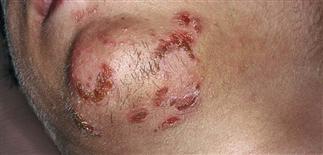46
Impetigo

Rounded, crusted papules and plaques on face. Crust is yellow and heavy-appearing. Lesions have some vesiculation at outermost edge.

Primary lesion is a flaccid, thin-roofed bulla. The larger lesions are secondary; they are erosions with peripheral collarette of scale, which is a typical evolution of bullous impetigo.

Faint erythema and yellow, honey-colored crusting of the nare base. Nasal carriers of S. aureus do not typically show this change; the carrier state is identified by inner nasal mucosa culture.

A collarette of scale surrounds pink, previously infected skin. There are a few tiny vesicles and some yellow crusting in this case of impetigo affecting the fingers.
DESCRIPTION
Impetigo is a common, contagious, superficial skin infection produced by Streptococcus pyogenes and/or Staphylococcus aureus. Bullous impetigo and non-bullous impetigo are two forms. S. aureus is the primary pathogen.
HISTORY
• Impetigo may occur after a minor skin injury such as an insect bite, or within lesions of atopic or other dermatitis. • Children in close physical contact have higher infection rate. • Responsible staphylococci may colonize nose, serving as reservoir for skin infection. • Warm, moist climates and poor hygiene predispose.
PHYSICAL FINDINGS
Lesions may be localized or widespread. Common on face. • Bullous impetigo. Thin-roofed bullae may turn from clear to cloudy. Bullae collapse, leading to an inner tube-shaped rim with central, thin, honey-colored crust. Lesions enlarge and often coalesce with minimal surrounding erythema. Thick crust accumulates over time. Lesions found in all stages. • Non-bullous impetigo (crusted). Vesicles or pustules rupture, exposing red, moist base. Scaling border forms as round lesions enlarge. Honey-yellow to white-brown crust accumulates as lesion extends radially; little surrounding erythema. Satellite lesions appear beyond periphery. Systemic symptoms infrequent. Lesions generally asymptomatic, painless.
Incidence of acute nephritis 2–5%; if nephritogenic streptococcal strain, rate varies between 10% and 15%. Rheumatic fever not reported as a complication.
S. aureus a common infection with potential complications, particularly if some immune suppression exists. Recurrence following therapy is common. Culture typically grows S. aureus, less commonly, group A Streptococcus.
TREATMENT
• For limited infection, mupirocin 2% ointment or cream (Bactroban) t.i.d. for 10 days. • Neomycin-bacitracin creams also effective. • For widespread infections, oral therapy such as dicloxacillin 250 mg or cephalexin (Keflex) 250 mg q.i.d. for 5–10 days. Pediatric doses cephalexin 40–50 mg/kg t.i.d. for 10 days, amoxicillin plus clavulanic acid 20 mg/kg t.i.d. for 10 days. For penicillin-allergic, azithromycin given over 5 days (500 mg on day 1 and 250 mg on days 2–5) or clarithromycin 250–500 mg b.i.d. for 10 days may be effective. • For recurrent impetigo, seek occult S. aureus. Most common site is the nares. Less commonly in perineum, axillae, and toe webs. • Mupirocin 2% ointment for recurrent disease, applied to nares b.i.d. for 5 days. Repeat monthly for several months.







